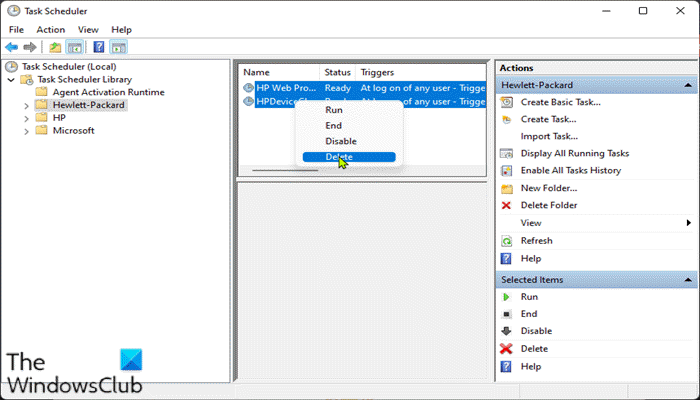Delete Scheduled Task in Windows 11/10
If you no longer need or want a scheduled task, you can delete them from your computer. We can delete Scheduled Task in Windows 11/10 in easy ways. We’ll explore this topic under the methods outlined below in this section as follows.
1] Delete Scheduled Task via Task Scheduler
To delete Scheduled Task via Task Scheduler in Windows 11/10, do the following:
Press Windows key + R keys to invoke the Run dialog.In the Run dialog box, type taskschd.msc and hit Enter to open Task Scheduler.In the left pane of Task Scheduler, expand the Task Scheduler Library.Now, select the folder that contains the task(s) you want to delete.In the middle pane of the opened folder, select one or more task(s) you want to delete.
Note: If you want to delete more than one task, you can press and hold the Ctrl key while clicking on the tasks one after the other to highlight all.
Once you have selected all the tasks you want to delete, you can either click on Delete under Selected Items in the right Actions pane or click on Action (Alt+A) on the toolbar, and click Delete (Alt+D), or right-click on the selected task(s), and click Delete on the context menu.Click Yes on the prompt that pops up to confirm.Exit Task Scheduler when done.
Read: How to rename scheduled task in Windows Task Scheduler.
2] Delete Scheduled Task via Command Prompt
To delete Scheduled Task via Command Prompt in Windows 11/10, do the following:
Press Windows key + R to invoke the Run dialog.In the Run dialog box, type cmd and then press CTRL + SHIFT + ENTER to open Command Prompt in elevated mode.In the command prompt window, type either of the command below and hit Enter.
This command is for the task in root Task Scheduler Library folder.
This command is for tasks in a folder other than the root folder.
Be sure to replace the
Exit command prompt when done.
3] Delete Scheduled Task via Registry Editor
To delete Scheduled Task via Registry Editor in Windows 11/10, do the following: Since this is a registry operation, it is recommended that you back up the registry or create a system restore point as necessary precautionary measures. Once done, you can proceed as follows:
Press Windows key + R to invoke the Run dialog.In the Run dialog box, type regedit and hit Enter to open Registry Editor.Navigate or jump to the registry key path below:
At the location, in the left pane, expand the subkey for the folder containing the task(s) you want to delete.Next, right-click on the task name you want to delete.Click Delete on the context menu.Click Yes on the prompt to confirm.Exit Registry Editor when done.
That’s it on how to delete Scheduled Task in Windows 11/10! Related post: How to enable, view, and clear Task Scheduler History.
How do I kill a scheduled task in Windows?
PC users can stop/kill a running task from completing its actions by ending it. To kill a scheduled task in Windows 11/10, you can follow these instructions: Select the task and, under Selected Item, click or tap End. In the scenario where your task has the If the running task does not stop when requested, force it to stop option enabled, the task is forced to end if it did not stop when you tried to end it.
How do I edit Scheduled Tasks in Windows?
If you have successfully created a task on your Windows PC and wish to edit the scheduled task, you can follow these instructions: Open Task Scheduler. Find the created task. When you have found it, right-click on it and choose Properties. In the Properties window click on the Triggers tab and then click the Edit button at the bottom of the edit task window. You should be able to make any changes you want from there.
Why does Task Scheduler use so much CPU?
In Windows 11/10 system, if the Task Manager does not show why you have high CPU usage, the most likely cause is background processes. If in Task Manager you notice that nothing is hoging the system resources but there is a high CPU usage, you can try the following suggestions:
Run a full system AV scan.Check the Startup programs.
What happens if I disable Task Scheduler?
Basically, if you disable a task while it is running on your Windows system, what happens is that the action does not stop the current execution – the current process will continue to run until it finishes. Just all next scheduled tasks executions on your PC will be disabled.

